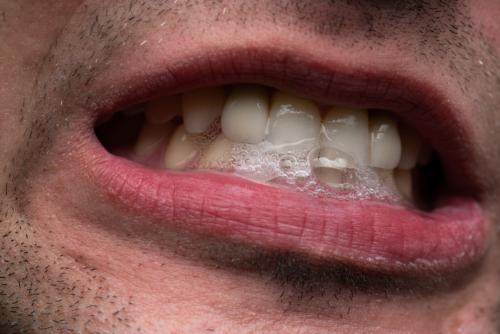What diseases can hide nasal bleeding?

The patient is anxious, agitated, scared by bleeding from the nasal nose. The general condition will be evaluated quickly, at the same time as giving first aid. The anamnesis will focus on the onset of onset, duration, conditions of occurrence, patient's background treatment (especially anticoagulant medication), and assessment of the abundance of bleeding. Depending on the loss, epistaxis may be: mild, moderate or severe. At the clinical examination, the exact location of the bleeding site is attempted. Depending on the bleeding site, epistaxis can be: - Unilateral or bilateral - Anterior or posterior - Diffuse.
DescriptionEpistaxis is an urgent ENT that may cause local or general occurrence. • Nasal trauma: accidental, aggression, nasal soreness, intranasal foreign bodies (exogenous or endogenous - rhinolithiasis), iatrogenic - postsurgical • Nasopharyngeal inflammation: or acute rhinosinusitis • Environmental factors (altitude) • Anatomical anomalies / variants . nasal septum crest • Benign tumors: - Hemangioma - can occur at any age and frequently affect (especially the Kiesselbach vascular patch); . • Malignant tumors: - epithelial and neuroectodermal tumors: carcinoma, adenocarcinoma, - haematopoietic tumors: lymphomas, plasmocytomas, - soft-tissue tumors (angio-, fibro-, rhabdomio-, leiomio-), malignant histiocytoma, malignant hemangiopericitoma . • Cardiovascular pathology: - de novo or insufficiently controlled drug - is the most common cause in the episode of epistaxis and often bleeding stops with the normalization of tensions, - atheromatosis, - mitral decompensations, - coagulopathies: anticoagulation, anomalies .
• Renal causes: glomerulonephitis • Endocrine causes: pheochromocytoma, pregnancy • Hereditary teleangiectasal haemorrhagic disease - Rendu-Osler's disease • Vascular syndromes: Sturge-Webber, Maffuci, Von Hipple-Lindau • Strong physical exertion, . The correct attitude is to place the patient in a sitting position with the head bent forward or laterally decapitated with the head (if it has a tendency to lipo-myme). If the nara bleeding is identified, it will be pressed (digital compression); . A normal bleeding time is less than 10 minutes, ideal for a maximum of 4 minutes. So this nasal compression should be kept for at least 4 minutes or until the doctor or nurse arrives.
Think of local venous compression after harvesting venous blood - the same principle applies to nasal bleeding. Hand lift did not prove to be effective in stopping epistaxis, and patient stretching on the back is totally unlabeled as it will increase the amount of blood in the neck, mouth, causing the sensation of drowning, choking. The blood accumulated in the oral cavity will spit, because once it gets into the stomach it will irritate the gastric mucosa and will produce a general malaise with nausea and. Therapeutic conduction involves: local haemostasis, hydroelectrolytic rebalancing, identification and treatment of the cause. Once in the emergency room, the patient must be quiet and assured that they have been taken over by the medical staff who will do their best to help.
If the patient can not answer the physician's questions, the physicians can provide valuable information about the cause, the mode of epistaxis, the possible allergies of the patient, the patient's personal medication. anticoagulation) - The first aid measures will be applied correctly - Blood pressure will be measured - Anamnesis - Bleeding rate is assessed: agitation, cyanosis, pallor, hypotension, polypnea - Will be harvested . Treatment maneuversWe will apply vasoconstrictor tables and perform digital compression. For minor epistaxis, spontaneously stopped or digital compression, a haemostatic sponge is applied to the physician's opinion and / or local topical solutions of trophic solutions for the nasal mucosa are recommended - the most affordable and cheap solution is. There are also commercial formulations of ointments with a blend of substances with increased efficacy in curing the nasal mucosa.
The classic interventional maneuvers for moderate epistaxis, which do not spontaneously stop, are: - chemical cauterization (with silver nitrate) - electrical cauterization (using the mono or bipolar electrocautery) - is a moderately painful procedure but can be performed under - . For special cases with bleeding that can not be controlled by these maneuvers, use is made of: - posterior nasal swab with mesa (lately used less) or with balloon probe, - external or endoscopic vascular ligatures, - embolization . General support of the patient involves: hydroelectrolytic rebalancing with general state improvement, coagulation processes (izogrup izoRh), hygienic-dietary regimen. Mild nasal bleeding stops spontaneously and requires local supportive trophic treatment. Moderate or abnormal epistaxis needs hospital treatment and investigation of generative causes.
Patients with recurrent episodes, whether they are in small quantities, should be consulted by the ENT, given a nasal route, and may be recommended to perform imaging CT or RM imaging. Dr. . .
Source : sfatulmedicului.ro
Views : 2918
Popular Article
- (photo) Nude becomes art.
Posted: 2018-03-17, 9589 views.
- The harmful effects of air conditioning on the skin
Posted: 2017-06-08, 8269 views.
- 3 causes of dyed hair discoloration
Posted: 2017-06-15, 8142 views.
- Why early puberty occurs in girls: symptoms, favors, diagnosis and treatment
Posted: 2017-10-24, 7999 views.
- Good or bad skin treatments in the hot season
Posted: 2017-06-07, 7737 views.
Recommendations
- (photo) Nude becomes art.
Posted: 2018-03-17, 9589 views.
- The harmful effects of air conditioning on the skin
Posted: 2017-06-08, 8269 views.
- 3 causes of dyed hair discoloration
Posted: 2017-06-15, 8142 views.
- Good or bad skin treatments in the hot season
Posted: 2017-06-07, 7737 views.
- Risks of practicing sports on hot days
Posted: 2017-06-12, 7330 views.
 4 effective ingredients in the fight against acne.
4 effective ingredients in the fight against acne. How to get rid of hiccups fast
How to get rid of hiccups fast The wheat bran diet: the secret of lost pounds as if by magic
The wheat bran diet: the secret of lost pounds as if by magic The recipe that will sweeten your soul this weekend!
The recipe that will sweeten your soul this weekend!  Is it dangerous or not to refreeze meat after thawing it?
Is it dangerous or not to refreeze meat after thawing it?  The unusual sign of diabetes indicated by saliva.
The unusual sign of diabetes indicated by saliva. What to drink to boost your immune system.
What to drink to boost your immune system. 10 foods that help you never age.
10 foods that help you never age. What actually happens in your body if you drink a cup of coffee for breakfast
What actually happens in your body if you drink a cup of coffee for breakfast 5 surprising benefits of chia seeds
5 surprising benefits of chia seeds